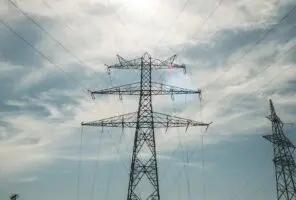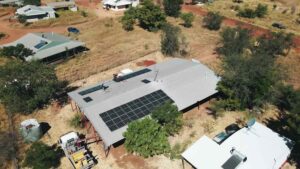Thousands of people flocked to the Everything Electric show in Sydney over the weekend, the largest electric car and home energy show in the southern hemisphere.
Last year the show debuted in Australia under the name Fully Charged. This year it was held in a bigger venue at the Sydney Showground with twice the number of electric vehicles, and an emphasis on home energy electrification and efficiency.
As well as providing opportunities to test drive electric vehicles and other forms of e-transport, a home energy advice team was on hand to answer questions from the public.
Lorenzo Tassone, the CEO from Good Earth Group, was one of the advisers. He runs a one-stop shop in western Sydney which provides energy efficient solutions that can cut power bills and put people on a path to a net zero future.
And whilst everyone’s situation will be different, and require different solutions, Tassone’s presentation, ‘The Pathway to Net Zero’, had some top tips on how to electrify your home and make it more energy efficient which we’ve summarised here:
1. Install energy efficient appliances not massive solar systems
With a return on investment within 4 or 5 years, solar is a no-brainer for anyone who can afford it. Whilst there are many other energy efficient measures householders can take, solar panels open up other opportunities for energy efficiency.
Opinions vary among energy efficiency experts, but most argue that if you have energy efficient appliances, you don’t need a big, huge solar system to cover your energy costs.
However, Tassone says it’s still important to size your system for future needs: Are you looking to invest in a electric car? How do you use that car? Do you work from home? Do you travel to work?
“You don’t necessarily need to put a huge extra system on to cover your vehicle load if you’re only doing local kilometres or local miles.”
2. Install a home battery, feed back to the grid at night, and pay it off in a few years
Currently the payback on a home battery is around 12 or 13 years, so for many people it doesn’t make economic sense to invest in one.
However, if you do have solar panels and a battery, and you’ve got excess power that you’ve generated during the day, you can now sell that back to the grid in the evenings when the feed-in rate is 50 to 60 cents per kw.
“That’s changed the landscape because the batteries typically have a 10-year warranty,” says Tassone.
“Your return on investment comes down to four or five years by trading the excess electricity you don’t need, and earning some money to pay back that battery quicker.”
Norman Koslowski from Sky High Energy Control, an independent cleantech energy company, says there’s another reason why householders in NSW and Victoria might not want to put a massive solar array on your roof, unless you have a battery.
“From July 1, if you export your solar between 10am and 3pm, you’ll now pay a charge for anything over six kilowatts that you export to the grid,” says Koslowski. “But the [network providers] will give you a feedin credit if you export between 3pm and 8pm during peak period.”
The network providers are basically trying to get us to load shift our excess solar from the middle of the day to when they need the power in the evening.
There are currently around 3.5 million rooftop solar systems in Australia – around 37% of all households – and only 180,000 batteries installed.
Koslowski fears that without the personnel to install millions of batteries, we may have a bottleneck coming. “They’re going to incentivize everyone to get a battery because that’s what they need but they’re going to worry what they wish for.”
Rather than charge householders to export their excess solar during the day, some power companies, especially in South Australia, are now able to shut off your excess solar production and shut down your solar system remotely.
“There’s pros and cons to that,” says Tassone. “It’s good for them and for the grid. But it’s not good for you if you’re trying to keep things going in your house on a 40 degree day.”
3. Heat pumps are the most efficient heating systems ever invented
“If you’ve got an electric hot water system and you [replace it with] a heat pump in, you can save about 75% on your power bill straight up,” says Tassone.
Heat pumps use the ambient outdoor temperature to heat water, so they can work all year round in inclement conditions. Unlike the old solar hot water systems which don’t work when it’s cloudy and overcast.
However, the quality of heat pump hot water systems vary considerably and there are several things to consider when researching and buying one. There are now several cheap ones on the market with very low warranties.
“You get what you pay for,” says Tassone. “Subsidies subsidize the tank up front, but if that tank only lasts a year, you’ve got to pay full ticket price in 12 months for another one.”
Good Earth claim to be ‘technology agnostic’ and don’t have deals with any specific company, but one of the brands they recommend is Reclaim. “Their tanks are made in Australia, they have a 10-year warranty, the inverters are Japanese and they now have a 7-year warranty on those. So the technology is really good,” says Tassone. “They also use CO2 as a refrigerant and that means the gas has zero global warming potential.”
If you have a resistive electric hot water tank and your power bill is about $1,000 per annum, Tassone estimates it will drop to about $140 for most people after putting a heat pump in.
“You can then drop that another $100 if you’ve got a solar system because you’re running a heat pump during the middle of the day when they’re most efficient, so you will almost be getting free hot water.”
Heat pumps for high rise apartment buildings need a lot of space for the storage tanks so if there’s no space, it’s not an easy solution to retrofit. However, Tassone says there are solutions.
For more tips, please see the rest of this story at our SwitchedOn sub-site, dedicated to the electrification of everything. Anne Delaney is the editor of SwitchedOn and the host of its weekly SwitchedOn podcast.










